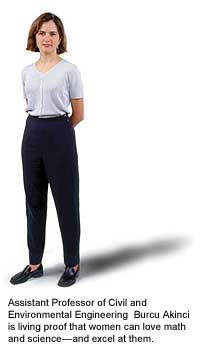Burcu Akinci is living proof that women can love math and science, too. The energetic assistant professor of civil and environmental engineering at Carnegie Mellon University says she has been interested in math and science ever since she was very young.
“I come from a family of engineers, so I guess it’s in my genes,” said Akinci, whose mother was among a group of Europe’s first female engineers to work in construction.

Her perspective is welcome amid the furor that the U.S. must work harder to close the gender gap in science. Women took home 47.1 percent of all science and engineering undergraduate degrees awarded in the U.S. in 2000, but only about one-fifth of undergraduate engineering degrees that year, according to the National Science Foundation.
And a recent study by the American Society for Engineering Education reports that women earning university faculty positions in the past three years has increased from 8.99 percent in 2001 to 9.9 percent in 2003.
Still, it’s pretty clear that women are not only interested in getting to the lab, but they also enjoy getting to job sites to test new technologies.
The Turkish-born Akinci is currently leading a research team involved with testing the efficacy of Radio Frequency Identification (RFID) tags.
“The relatively small tags use radio signals to report their identity and other data whenever they are within range of special readers,” Akinci said. “When a project calls for thousands of pre-fabricated pipes and a storage yard comparable to an airport runway, managers need a tool that will help them keep track of their stuff,” she said.
Akinci is leading a Carnegie Mellon research team that is working with concrete fabricator High Concrete Structures Inc. of Denver, Pa., to test the RFID tags in a storage yard.
Bob Grasser, a master scheduler at High Concrete Structures Inc., said he wants to combine RFID and other locating systems so crane operators can find construction pieces, without leaving the cab.
“This field work is all about helping industry improve quality and making the workplace more technologically savvy,” Akinci said.
In fact, industry analysts report that this technology together with other data collection technologies, such as laser scanners and embedded sensing systems, could avert cost overruns of between 5 and 12 percent for some construction jobs. In addition to industry accolades, Akinci gets high marks from her academic colleagues.
“I have been very impressed with her ability to develop and to lead a group focused upon integrating sensor information and CAD models for construction sites,” said Chris Hendrickson, head of the Department of Civil and Environmental Engineering and faculty director of the Steinbrenner Institute for Environmental Education and Research.
When Akinci is not teaching or doing her field test research, she spends time with her family. “It is always a balancing act, but I have disciplined myself to make time for both family and work,” said Akinci, the proud mother of 2-year-old twin boys Arda and Kaya, and 8-year-old daughter Sinem.
Akinci received her Ph.D. in civil and environmental engineering from Stanford University. She is the 2003 recipient of the prestigious George Tallman Ladd Research Award from Carnegie Mellon’s College of Engineering and a National Science Foundation Career Award, which recognizes the academic leaders of the 21st century.
Related Links:
Burcu Akinci
Chris Hendrickson
Civil and Environmental Engineering Department



